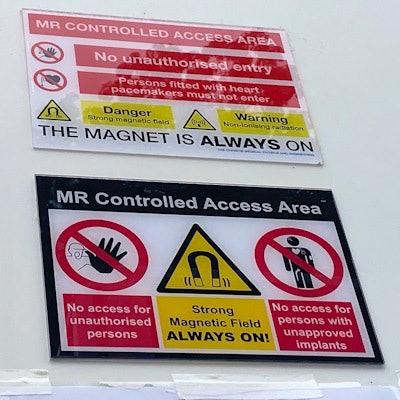
A successful approach to MRI safety must involve a multidisciplinary team effort to arrive at good local decisions, according to Geoff Charles-Edwards, PhD, head of MR physics at Guy's & St Thomas' NHS Foundation Trust in London.
"MR safety is not binary," he told delegates at the British Institute of Radiology (BIR) annual congress. "There is always some sort of risk associated with pretty much everything, so the appropriate way really is to try and understand what the risk is, weigh it up against the perceived benefits, and try and manage it in that situation. To make that call you need to understand both the risks and clinical need -- that itself is quite a challenge."
Risk assessments should be overseen by a safety expert/technician who obtains input from radiologists, radiographers, referring clinicians, and other specialists, said Charles-Edwards, who is a consultant clinical scientist at Guy's & St Thomas' and an honorary senior research fellow at King's College London.
 Clear and visible warning signs have an essential role to play in MRI safety.
Clear and visible warning signs have an essential role to play in MRI safety.Cardiovascular devices and MRI
In the U.K., professional bodies have embarked on a major collective effort to ensure patients with cardiac implantable electronic devices (CIEDs) get better access to safe scanning. Currently, only around half of National Health Service facilities accept scan requests for patients with MR conditional CIEDs.
"These are cardiac devices where the manufacturer has said it's okay to scan if you follow certain conditions, but we're still lagging behind in terms of numbers of sites that will scan them," he told BIR delegates on 22 September.
Access remains limited, despite growing safety data to support MR scanning in patients with CIEDs that do not have MR safety labeling or with MR Conditional CIEDs in which certain conditions are not met, for which the clinical justification is robust, he added.
Charles-Edwards has helped to draw up the joint British Society consensus recommendations for MRI for patients with CIEDs, which launched earlier in September. He said the guidelines were designed to improve patient access while supporting clinicians to make local decisions.
Significantly, the new advice says the majority of patients with CIEDs should now be able to undergo MRI. For patients with so-called MR unlabelled or conditional devices for which it is not possible to meet all the specified conditions, a local risk-benefit decision is needed, he explained.
"MR scanning of patients with some sort of implants, when we don't have complete assurance from the device manufacturer that it's safe to scan, is appropriate if the clinical need outweighs the risk," said Charles-Edwards.
"These recommendations came from a multiprofessional working group (with representation from the BIR, organizations representing professional groups, patient groups, and the U.K. regulatory body, the MHRA) -- this is a big collective effort," he continued. "It aims to try to get more sites started in terms of scanning patients with MR conditional cardiac devices."
Charles-Edwards described how a "more conservative approach" to risk had been pursued historically, fed partly by "unfortunate deaths in early years of MR patients with cardiac devices". Then, it was assumed any unidentified implant was unsafe and patients were not to be scanned but that approach had been challenged over time.
The newly published consensus guidance states that "Service delivery requires specialist equipment and robust protocols to ensure patient safety and facilitate workflows, meanwhile demanding collaboration between healthcare professionals across many disciplines."



















